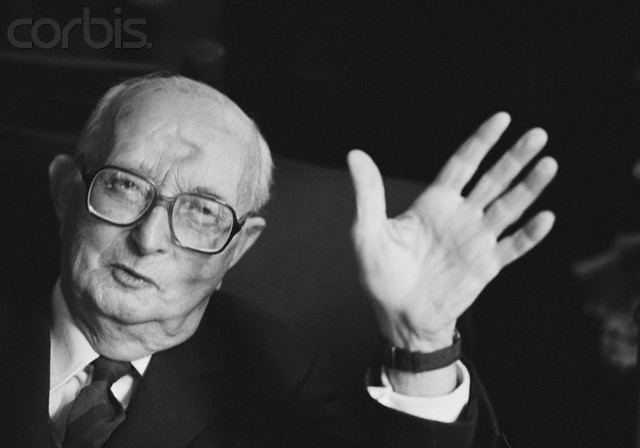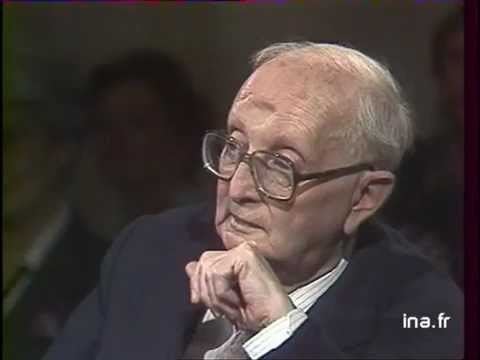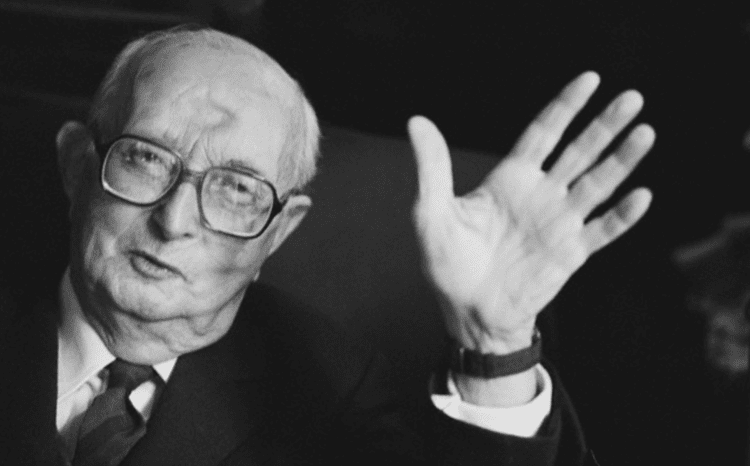Name Maurice Bardeche | Role Essayist | |
 | ||
Died July 30, 1998, Paris, France Books Nuremberg Or the Promised Land, Nuremberg, Ou, La Terre Promise, The history of motion pictures Education Lycee Louis-le-Grand, Ecole Normale Superieure | ||
UN HOMME, UN DESTIN : MAURICE BARDECHE
Maurice Bardèche | Wikipedia audio article
Maurice Bardèche (1 October 1907 – 30 July 1998) was a French essayist, literary and art critic, journalist, and one of the leading exponents of neo-fascism in post–World War II Europe. Bardèche also became a leading Holocaust denier and wrote extensively on the subject in his later life. Bardèche was also the brother-in-law of the collaborationist Robert Brasillach, executed after the liberation.
Contents
- UN HOMME UN DESTIN MAURICE BARDECHE
- Maurice Bardche Wikipedia audio article
- Academic career
- After World War II
- Works
- References
Academic career

Bardèche was born in a modest family of Dun-sur-Auron in the Cher department on 1 October 1907. A product of the educational opportunities of the Third Republic, Bardèche had received a scholarship, and completed hypokhâgne at the prestigious Lycée Louis-le-Grand in Paris. There, he met Thierry Maulnier and his future brother-in-law Robert Brasillach, establishing lifelong connections. In 1928, he entered the École normale supérieure (ENS), where he met with the philosopher Simone Weil (whom he nicknamed the "Red Virgin", after Louise Michel), Claude Jamet, Jacques Soustelle, Roger Vailland and Georges Pompidou, future President of France. He was received at the Agrégation (literary section) in 1932, and started teaching at the Sorbonne University. A year later, he described himself as "a snail withdrawn into its shell".

He was heavily influenced by the nationalist intellectual Maurice Barrès and the leader of the monarchist Action française (AF), Charles Maurras.
Bardèche initially came to prominence as an associate of Brasillach and Maulnier, writing in their journals (1933, 1934, 1935), essentially as a literary chroniquer. During the Spanish Civil War (1936–1939), he traveled several times to the country and wrote with Brasillach a History of the Spanish War, in which he called for the violent defense of "order" and of Francoism in front of "paralysing democracy, one like malaria". Seduced by José Antonio Primo de Rivera's Falange, his support of Fascism may be dated to this period. Bardèche also co-authored with Brasillach a History of Cinema (1935), a work that influenced cinema history for years.

Bardèche completed his thesis on Balzac in 1940, titled La formation de l’art du roman chez Balzac jusqu’à la publication du Père Goriot, from which he would publish a biography, Balzac romancier. He continued to teach at the Sorbonne, moving to the Université des Sciences et Technologies de Lille from 1942-4. He then became recognized for his critical works.

Bardèche began to write for the fascist journal Je suis partout in 1938. During the German occupation, he didn't take a position. After the execution of Brasillach, he claimed that the Resistance's "excesses", the bombing of Dresden and post-liberation atrocities were war crimes.
After World War II
After the liberation, he was briefly arrested for collaborationism but quickly released, while his brother-in-law, Robert Brasillach, was executed. He denounced Brasillach's death as "criminal". Bardèche was expelled from the National Education, proscribed from giving courses in the public education system. He then founded his own literary publishing house, Les Sept Couleurs (The Seven Colours), and also founded a right-wing journal titled Défense de l'Occident in 1952, dedicating himself to rehabilitating Brasillach's works and ideology.
He wrote a Lettre à François Mauriac in 1947, in which he attacked the épuration légale (legal purge) of Vichy supporters, defended collaborationism and criticized Resistance members whom he called "rebels against legality". His 1948 follow-up, Nuremberg ou la Terre Promise, which was an attack on the Nuremberg Trials and one of the earliest expression of Holocaust denial, saw him sentenced to a year's imprisonment for apology of war crimes, while the book was censored. This feat saw him become recognized as one of the leading thinkers of neo-fascism. However, Bardèche never served his prison term, as his sentence was commuted by President René Coty, and he was only imprisoned for a few weeks in Fresnes.
He was a founder of the European Social Movement (MSE) in 1951 and became its vice-president, which brought him together with leaders such as Oswald Mosley, Karl-Heinz Priester and Per Engdahl. He continued publishing his journal Défense de l'Occident from 1952 to 1982, in which ideas of a European nationalism were espoused.
In 1952, he wrote another negationist book, basing it on Paul Rassinier's arguments.
Unlike some of his contemporaries, Bardèche made no secret of his fascism and famously wrote in the introduction to his 1961 work Qu'est-ce que le fascisme? "I am a fascist writer." He was particularly attracted to the Italian Social Republic and sought to use that model as the basis for a more contemporary ideology that he termed fascisme amélioré ("improved fascism"). Bardèche also became a leading Holocaust denier and wrote extensively on the subject in his later life.
He died in Paris in 1998. He was described as "a prophet of a European renaissance for which he had long hoped" by Jean-Marie Le Pen [1], leader of the National Front party. His wife Suzanne died in 2005.
In 2012, the eldest of his five sons, Jacques Bardèche, made a tribute to his father on a self-proclaimed "unconformists" podcast website.
